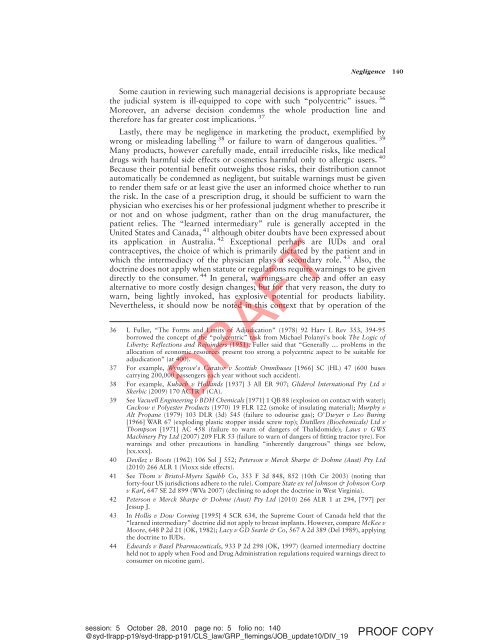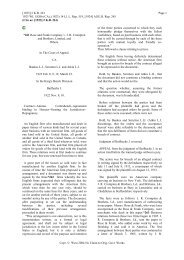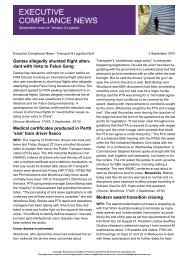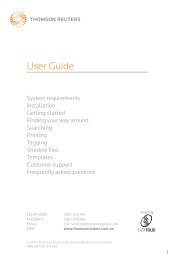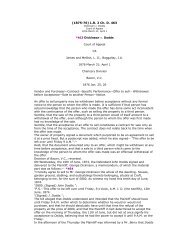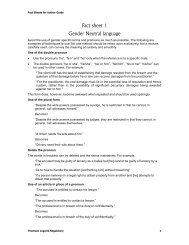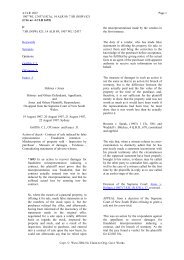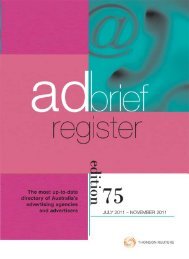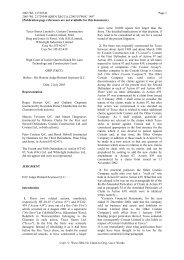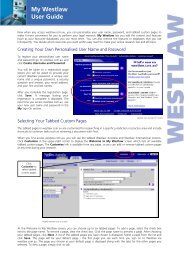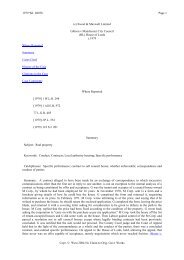Chapter 23: Product Liability - Thomson Reuters
Chapter 23: Product Liability - Thomson Reuters
Chapter 23: Product Liability - Thomson Reuters
Create successful ePaper yourself
Turn your PDF publications into a flip-book with our unique Google optimized e-Paper software.
Negligence 140Some caution in reviewing such managerial decisions is appropriate becausethe judicial system is ill-equipped to cope with such “polycentric” issues. 36Moreover, an adverse decision condemns the whole production line andtherefore has far greater cost implications. 37Lastly, there may be negligence in marketing the product, exemplified bywrong or misleading labelling 38 or failure to warn of dangerous qualities. 39Many products, however carefully made, entail irreducible risks, like medicaldrugs with harmful side effects or cosmetics harmful only to allergic users. 40Because their potential benefit outweighs those risks, their distribution cannotautomatically be condemned as negligent, but suitable warnings must be givento render them safe or at least give the user an informed choice whether to runthe risk. In the case of a prescription drug, it should be sufficient to warn thephysician who exercises his or her professional judgment whether to prescribe itor not and on whose judgment, rather than on the drug manufacturer, thepatient relies. The “learned intermediary” rule is generally accepted in theUnited States and Canada, 41 although obiter doubts have been expressed aboutits application in Australia. 42 Exceptional perhaps are IUDs and oralcontraceptives, the choice of which is primarily dictated by the patient and inwhich the intermediacy of the physician plays a secondary role. 43 Also, thedoctrine does not apply when statute or regulations require warnings to be givendirectly to the consumer. 44 In general, warnings are cheap and offer an easyalternative to more costly design changes; but for that very reason, the duty towarn, being lightly invoked, has explosive potential for products liability.Nevertheless, it should now be noted in this context that by operation of the36 L Fuller, “The Forms and Limits of Adjudication” (1978) 92 Harv L Rev 353, 394-95borrowed the concept of the “polycentric” task from Michael Polanyi’s book The Logic ofLiberty: Reflections and Rejoinders (1951). Fuller said that “Generally … problems in theallocation of economic resources present too strong a polycentric aspect to be suitable foradjudication” (at 400).37 For example, Wyngrove’s Curator v Scottish Omnibuses [1966] SC (HL) 47 (600 busescarrying 200,000 passengers each year without such accident).38 For example, Kubach v Hollands [1937] 3 All ER 907; Gliderol International Pty Ltd vSkerbic (2009) 170 ACTR 1 (CA).39 SeeVacwellEngineeringvBDHChemicals [1971] 1 QB 88 (explosion on contact with water);Cuckow v Polyester <strong>Product</strong>s (1970) 19 FLR 122 (smoke of insulating material); Murphy vAlt Propane (1979) 103 DLR (3d) 545 (failure to odourise gas); O’Dwyer v Leo Buring[1966] WAR 67 (exploding plastic stopper inside screw top); Distillers (Biochemicals) Ltd vThompson [1971] AC 458 (failure to warn of dangers of Thalidomide); Laws v GWSMachinery Pty Ltd (2007) 209 FLR 53 (failure to warn of dangers of fitting tractor tyre). Forwarnings and other precautions in handling “inherently dangerous” things see below,[xx.xxx].40 Devilez v Boots (1962) 106 Sol J 552; Peterson v Merck Sharpe & Dohme (Aust) Pty Ltd(2010) 266 ALR 1 (Vioxx side effects).41 See Thom v Bristol-Myers Squibb Co, 353 F 3d 848, 852 (10th Cir 2003) (noting thatforty-four US jurisdictions adhere to the rule). Compare StateexrelJohnson&JohnsonCorpv Karl, 647 SE 2d 899 (WVa 2007) (declining to adopt the doctrine in West Virginia).42 Peterson v Merck Sharpe & Dohme (Aust) Pty Ltd (2010) 266 ALR 1 at 294, [797] perJessup J.43 In Hollis v Dow Corning [1995] 4 SCR 634, the Supreme Court of Canada held that the“learned intermediary” doctrine did not apply to breast implants. However, compareMcKeevMoore, 648 P 2d 21 (OK, 1982); Lacy v GD Searle & Co, 567 A 2d 389 (Del 1989), applyingthe doctrine to IUDs.44 Edwards v Basel Pharmaceuticals, 933 P 2d 298 (OK, 1997) (learned intermediary doctrineheld not to apply when Food and Drug Administration regulations required warnings direct toconsumer on nicotine gum).DRAFTsession: 5 October 28, 2010 page no: 5 folio no: 140@syd-tlrapp-p19/syd-tlrapp-p191/CLS_law/GRP_flemings/JOB_update10/DIV_19PROOF COPY


